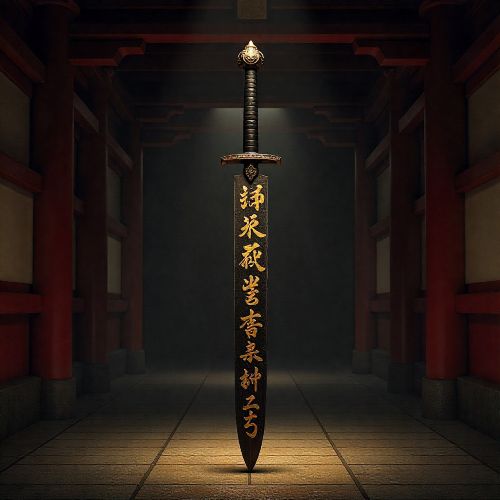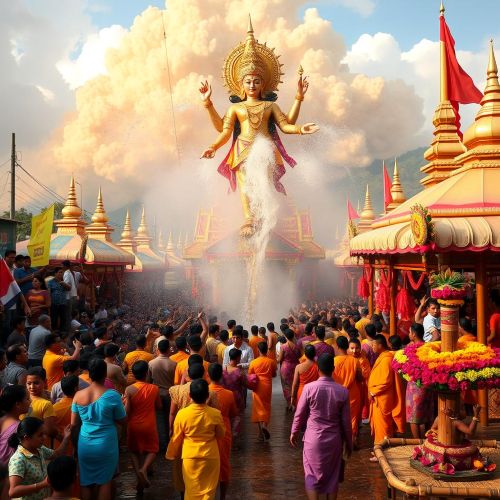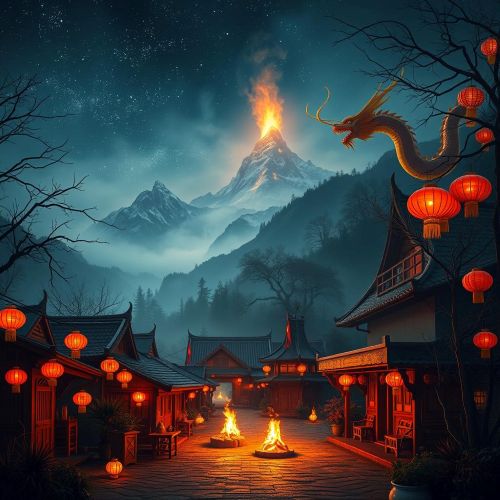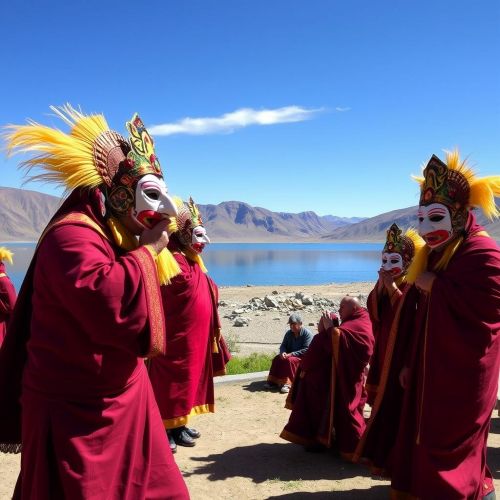Losar : Tibetan New Year
At a glance
| Description | |
|---|---|
| Location | Himalayan Region |
| Country | India, Nepal, Tibet, Bhutan |
| Dedicated To | Cultural Spirits |
| Duration | 3 days |
| Time of Year | January – March |
Introduction
Losar, the Tibetan New Year, stands as one of the most important and colourful celebrations in Tibetan culture. Marking the start of the lunar calendar, it is observed not only in Tibet but also in Bhutan, Nepal, Mongolia, and regions of India with Tibetan communities, such as Ladakh, Sikkim, and Himachal Pradesh. The term “Losar” comes from the Tibetan words lo meaning “year” and sar meaning “new.” Its origins go back centuries before Buddhism arrived in Tibet, beginning as a winter harvest festival rooted in ancient customs that honoured nature and local deities. Today, Losar blends these pre-Buddhist traditions with Buddhist philosophy, creating a celebration that is both spiritual and communal.
Connection with Mythology
The mythology of Losar reflects the intertwined histories of the Bon religion and Tibetan Buddhism. Long before Buddhist teachings reached the Himalayas, the Bon tradition held an annual incense-burning festival during the winter solstice. This ritual was aimed at driving away malevolent spirits and inviting protective forces for the year ahead. As Buddhism spread, its rich cosmology and pantheon of deities became incorporated into Losar celebrations.
A central myth linked to Losar involves protector deities, known as Dharmapalas, who safeguard the Buddhist teachings and the Tibetan people. Among them, Palden Lhamo holds a special place during the New Year—her fierce image and blessings are invoked to dispel misfortune and protect the coming year’s harmony. The festivities also connect to ancient beliefs about mountain gods, each said to preside over specific territories. These mountain deities, such as Yar-lha-sham-po and Gnyan-chen-thang-lha, were believed to influence weather, fertility, and prosperity, making their veneration an important part of Losar’s origins.
Legends like the story of Padmasambhava subduing hostile spirits to establish Buddhism in Tibet are retold during Losar, reinforcing the theme of transformation from chaos to order. The festival’s rituals—offerings, chanting, and symbolic cleansing—mirror these mythological victories, blending the spiritual past with living cultural practice.
Main Activities
Losar celebrations stretch over 15 days, but the most significant events occur in the first three days. Preparations begin weeks in advance, as families clean and decorate their homes to sweep away misfortune and make space for good luck. The air is filled with the scent of burning juniper, while markets brim with colourful goods and traditional treats.
The eve of Losar features Guthuk, a thick noodle soup containing symbolic items hidden inside dough balls. These surprises—such as wool for kindness or chili for a sharp tongue—are lighthearted fortunes for the year ahead. The evening ends with the “driving out the evil” ritual, where families symbolically expel bad spirits through firecrackers, straw torches, and chants.
The first day, Lama Losar, begins before dawn. People offer prayers and incense to deities and ancestors, then visit monasteries to receive blessings from lamas. Traditional dress is worn—women adorn themselves with turquoise, coral, and pearl jewellery, while men wear long-sleeved chubas.
The second day, Gyalpo Losar, is a day of public celebration. Friends and relatives exchange greetings, share butter tea, and enjoy barley beer. In earlier times, this was when nobles and monks exchanged formal greetings with royalty and government leaders.
The third day, Chokyong Losar, focuses on honouring protective spirits. Prayer flags in bright colours are hoisted on rooftops and hillsides, carrying prayers into the wind. Families perform incense offerings, asking for a prosperous harvest and protection from illness.
In rural areas, traditional games like horse racing, wrestling, and archery add to the festive atmosphere, while in cities, music and dance performances keep the streets alive. Altars at home, known as Chod-shom, are piled high with offerings—barley flour, fried pastries, butter sculptures, and sprouted wheat—symbolising abundance and renewal.
Importance in Cultural History
Losar is far more than a seasonal celebration—it is a cultural institution that embodies Tibetan identity. Historically, its formalisation is credited to King Pude Gungyal of the 2nd century BCE, who transformed earlier harvest and spiritual rituals into a structured New Year festival. Over centuries, Losar absorbed elements from Chinese, Mongolian, and Indian traditions, while maintaining its distinctly Tibetan essence.
The festival also marks an important moment of unity, where families gather regardless of distance or hardship. For Tibetans in exile, especially in India and Nepal, Losar has become a powerful symbol of resilience and cultural preservation in the face of displacement. The rituals, songs, and dances of Losar serve as a living link to their heritage, passing down oral histories and values to younger generations.
By incorporating acts of generosity, such as sharing food and making offerings, Losar also reinforces the Buddhist principle of compassion. In many ways, it is a time when spiritual practice, community solidarity, and seasonal renewal converge, ensuring that the traditions remain vibrant even in modern times.
International Appeal
While Losar is deeply rooted in Tibetan soil, its celebration has spread worldwide through the Tibetan diaspora. In countries like the United States, Canada, Australia, and across Europe, Tibetan communities organise public events featuring Cham dances, traditional music, and exhibitions of thangka art. These events not only allow Tibetans abroad to stay connected to their roots but also invite global audiences to experience and appreciate Tibetan culture.
The Dalai Lama often uses Losar as a moment to deliver messages of peace, compassion, and environmental stewardship to the world. His teachings during this time are broadcast internationally, attracting both Buddhists and non-Buddhists alike.
In recent years, there have been campaigns to have Losar officially recognised as a cultural holiday in various countries, with some schools and cities including it in their cultural calendars. Tourist interest in Losar is also growing, particularly in Lhasa, where the Potala Palace and Jokhang Temple become centres of vibrant activity. The kora, or pilgrimage circuit, around Jokhang Temple is especially busy, with devotees spinning prayer wheels and chanting mantras.
For travellers, Losar offers a unique opportunity to witness Tibetan traditions in full splendour. Visiting during the festival means experiencing not only the sights and sounds of celebration but also the deeper spiritual atmosphere that permeates the occasion. From the colourful prayer flags fluttering in the cold wind to the aroma of juniper incense and butter lamps glowing in monasteries, Losar provides a sensory immersion into Tibetan life and belief.
Source
Dorje, G. (2005). Tibetan Buddhist rituals. Wisdom Publications. https://www.wisdompubs.org/book/tibetan-buddhist-rituals
Samuel, G. (2012). Introducing Tibetan Buddhism. Routledge. https://www.routledge.com/Introducing-Tibetan-Buddhism/Samuel/p/book/9780415458573
Lopez, D. S. (1998). Prisoners of Shangri-La: Tibetan Buddhism and the West. University of Chicago Press. https://press.uchicago.edu/ucp/books/book/chicago/P/bo3644034.html
Snellgrove, D. (2002). The cultural heritage of the Himalayas. Serindia Publications. https://www.serindia.com/books/the-cultural-heritage-of-the-himalayas
Central Tibetan Administration. (2023). Losar: Tibetan New Year. https://tibet.net/losar-tibetan-new-year/
Frequently Asked Questions
Lorem ipsum dolor sit amet, consectetur adipiscing?
Lorem ipsum dolor sit amet, consectetur adipiscing elit. Praesent convallis vestibulum justo, ac tincidunt nunc vehicula quis. Nullam id dolor quis orci malesuada feugiat. Curabitur aliquet libero at urna ullamcorper, ac ultricies nulla dapibus.
Lorem ipsum dolor sit amet, consectetur adipiscing?
Lorem ipsum dolor sit amet, consectetur adipiscing elit. Praesent convallis vestibulum justo, ac tincidunt nunc vehicula quis. Nullam id dolor quis orci malesuada feugiat. Curabitur aliquet libero at urna ullamcorper, ac ultricies nulla dapibus.
Lorem ipsum dolor sit amet, consectetur adipiscing?
Lorem ipsum dolor sit amet, consectetur adipiscing elit. Praesent convallis vestibulum justo, ac tincidunt nunc vehicula quis. Nullam id dolor quis orci malesuada feugiat. Curabitur aliquet libero at urna ullamcorper, ac ultricies nulla dapibus.
Lorem ipsum dolor sit amet, consectetur adipiscing?
Lorem ipsum dolor sit amet, consectetur adipiscing elit. Praesent convallis vestibulum justo, ac tincidunt nunc vehicula quis. Nullam id dolor quis orci malesuada feugiat. Curabitur aliquet libero at urna ullamcorper, ac ultricies nulla dapibus.
Lorem ipsum dolor sit amet, consectetur adipiscing?
Lorem ipsum dolor sit amet, consectetur adipiscing elit. Praesent convallis vestibulum justo, ac tincidunt nunc vehicula quis. Nullam id dolor quis orci malesuada feugiat. Curabitur aliquet libero at urna ullamcorper, ac ultricies nulla dapibus.









